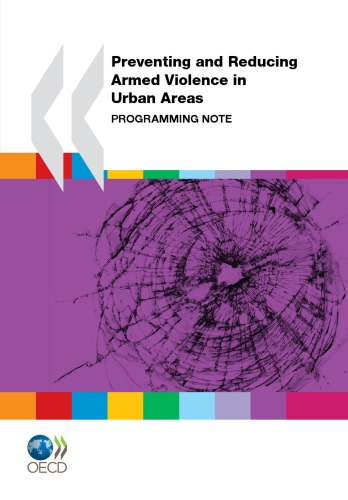

Most ebook files are in PDF format, so you can easily read them using various software such as Foxit Reader or directly on the Google Chrome browser.
Some ebook files are released by publishers in other formats such as .awz, .mobi, .epub, .fb2, etc. You may need to install specific software to read these formats on mobile/PC, such as Calibre.
Please read the tutorial at this link: https://ebookbell.com/faq
We offer FREE conversion to the popular formats you request; however, this may take some time. Therefore, right after payment, please email us, and we will try to provide the service as quickly as possible.
For some exceptional file formats or broken links (if any), please refrain from opening any disputes. Instead, email us first, and we will try to assist within a maximum of 6 hours.
EbookBell Team

4.1
50 reviews
ISBN 10: 9264060170
ISBN 13: 9789264060173
Author: Collective
1. Introduction: Understanding Urban Armed Violence
* 1.1 The Global Challenge of Urban Armed Violence
* 1.2 Why Urban Areas are Distinctive Contexts for Armed Violence
* 1.3 Purpose and Scope of this Programming Note
* 1.4 Linkages to Broader Conflict and Fragility Agendas
2. Key Concepts and Definitions
* 2.1 Defining Armed Violence, Urban Violence, and Gang Violence
* 2.2 Distinguishing Urban Armed Violence from Other Forms of Conflict
* 2.3 Key Drivers and Risk Factors in Urban Settings (e.g., weak governance, youth unemployment, illicit economies, rapid urbanization, social exclusion)
3. Assessment and Analysis for Urban Armed Violence
* 3.1 Importance of Context-Specific Analysis
* 3.2 Methodologies for Assessing Urban Armed Violence (e.g., public health approaches, security assessments, community consultations, mapping)
* 3.3 Identifying Hotspots and Vulnerable Populations
* 3.4 Understanding Actor Dynamics (e.g., gangs, informal security providers, state actors)
* 3.5 Gendered Dimensions of Urban Armed Violence
* 3.6 Data Collection and Ethical Considerations
4. Programming Approaches for Preventing and Reducing Urban Armed Violence
* 4.1 Holistic and Multi-Sectoral Approaches
* 4.2 Direct Programming Interventions:
* 4.2.1 Violence Reduction Initiatives (e.g., mediation, truce negotiation, gang interventions)
* 4.2.2 Security and Justice Sector Reform in Urban Contexts (e.g., community policing, access to justice)
* 4.2.3 Small Arms and Light Weapons (SALW) Control in Urban Areas
* 4.3 Indirect Programming Interventions:
* 4.3.1 Socio-Economic Development and Livelihoods (e.g., youth employment, vocational training)
* 4.3.2 Urban Planning and Infrastructure (e.g., safe public spaces, lighting)
* 4.3.3 Education and Skills Development for At-Risk Youth
* 4.3.4 Health and Psychosocial Support
* 4.3.5 Community Engagement and Social Cohesion Initiatives
* 4.4 Integrating Cross-Cutting Themes (e.g., gender, human rights, child protection)
5. Implementation Considerations and Challenges
* 5.1 Working in Politically Sensitive and High-Risk Environments
* 5.2 Engaging with Diverse Urban Actors (state, non-state, informal)
* 5.3 Coordination and Partnerships (local, national, international)
* 5.4 Capacity Building for Local Actors
* 5.5 Sustaining Interventions and Exit Strategies
6. Monitoring, Evaluation, and Learning
* 6.1 Developing Relevant Indicators for Urban Armed Violence Reduction
* 6.2 Measuring Impact and Attribution
* 6.3 Adaptive Management and Learning from Experience
* 6.4 Data Sharing and Knowledge Management
7. Policy Implications and Recommendations
* 7.1 Key Messages for Policymakers
* 7.2 Recommendations for Donors and Implementing Agencies
* 7.3 The Way Forward: Towards More Effective Urban Violence Prevention
preventing and reducing armed violence
preventing gun violence articles
preventing violent crime
preventing gun violence
preventing violence and abuse
Tags: Collective, Preventing, Violence